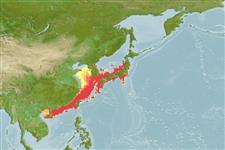Classification / Names
Common names from other countries
Main reference
Size / Weight / Age
Max length : 100.0 cm FL male/unsexed; (Ref. 168); max. published weight: 7.1 kg (Ref. 40637)
Environment
Marine; pelagic-neritic; oceanodromous (Ref. 51243); depth range 0 - 200 m (Ref. 54883)
Climate / Range
Temperate, preferred 17°C (Ref. 107945); 45°N - 18°N, 108°E - 143°E (Ref. 54883)
Distribution
Northwest Pacific: confined to the subtropical and temperate waters of China, the Yellow Sea and Sea of Japan north to Vladivostok, former USSR. Often confused with Scomberomorus munroi.
Countries | FAO areas | Ecosystems | Occurrences | Introductions
Short description
Dorsal
spines
(total): 19 - 21;
Dorsal
soft rays
(total): 15-19;
Anal
soft rays: 16 - 20;
Vertebrae: 48 - 50. Interpelvic process small and bifid. Lateral line gradually curving down toward caudal peduncle. The only species in the genus with a straight intestine. Swim bladder absent. Body covered with small scales. Anterior quarter of first dorsal fin and a narrow distal margin of the rest of the dorsal fin black. Sides with seven or more rows of longitudinal spots on the sides; some spots connected together.
IUCN Red List Status (Ref. 115185)
Threat to humans
Harmless
Human uses
Fisheries: highly commercial; aquaculture: commercial; gamefish: yes
More information
ReferencesAquacultureAquaculture profileStrainsGeneticsAllele frequenciesHeritabilityDiseasesProcessingMass conversion
Tools
Special reports
Download XML
Internet sources
Estimates of some properties based on models
Phylogenetic diversity index
PD50 = 0.5000 many relatives (e.g. carps) 0.5 - 2.0 few relatives (e.g. lungfishes)
Trophic Level
4.5 ±0.80 se; Based on food items.
Resilience
Medium, minimum population doubling time 1.4 - 4.4 years (K=0.7; Fec>100,000)
Vulnerability
Low to moderate vulnerability (34 of 100)
Price category
